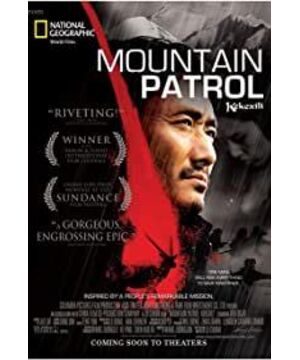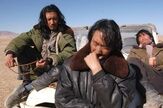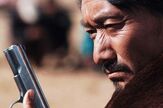Li Zehou commented that "Kekexili" "is a revolution in Chinese film aesthetics", and Rorty, a famous American "metaphilosophy", called it "the best film I have seen in ten years", shocked by its powerful reality. Chinese philosopher Zhao Tingyang also attributed the quality of "Kekexili" to "truth and power" in "The Last Shot of Hoh Xil".
"Kekexili" is highly praised by contemporary Chinese and foreign philosophers because of its unique aesthetic conception. Lu Chuan runs through the entire film of "Kekexili" with the pure naturalistic "cold aesthetics" rarely seen in mainland Chinese films, "expressing an aesthetic point of view that can be analyzed". (Zhao Tingyang, 2005)
1. Lens language:
If films are divided into analytical films and descriptive films (Susan Sontag, "Against Interpretation"), then "Kekexili" undoubtedly belongs to the latter. Its anti-psychoanalytical stance is so clear that the director treats the characters themselves as solid and closed solids, and a large number of shots focus on the field between people and between people and nature, rather than people's introspection or self-examination.
In the two scenes of death at the beginning and end, Lu Chuan chose to let the camera shoot a panorama (or even a large panorama) at a farther position. What the audience sees is, gunshots, a figure falls down, twitches, the shooter leaves, and that's it. In several main narrative paragraphs of the film, the people under the camera are always in a weak (or deliberately ignored) position. On the contrary, snow-capped mountains, grasslands, plateaus, and even large areas of Tibetan antelope carcasses occupy the main position of the picture. Against the background of the large area of cool colors, the power of people is compressed and squeezed. Whether it's the mountain patrol team led by Ritai crossing the glacier to hunt down illegal skinners, or these skinners being exiled by Ritai and walking out of the mountains alone in the wind and snow, the activities of people themselves are always secondary, and the important thing is the activities of people relationship with the natural environment. Therefore, even in the scene where a single character Liu Dong falls into quicksand until he is engulfed, even if there is the densest close-up in the whole film, the camera does not emphasize facial expressions. have higher performance value.
This cold and even cruel bystander perspective creates a documentary-like quality to "Kekexili", so that some viewers directly regard "Kekexili" as a documentary. Fortunately, this kind of misunderstanding is in "Nanjing! Nanjing! " is not performed again. Compared with the relatively single lens language and scene scheduling of "Kekexili", "Nanjing! Nanjing! "In Lu Chuan's use of camera language is more active and diverse. A large number of long-term close-ups of the characters' faces, especially the eyes, show the director's meticulous psychological depiction.
Unfortunately, similar remarks about some of the scenes being "too real to be acceptable" constitute a criticism of "Nanjing! Nanjing" was the most criticized by the audience. At this time, the audience may have overlooked that "truth" and the roughness, vigor, and coldness it brings are an important reason why "Kekexili" is widely praised.
2. Characters:
In "Kekexili", Lu Chuan's requirements for the actors are neither Brecht-style performances nor "method-style" experiences, but to "become". Therefore, even if the team members in "Kekexili" may have slurred speech, ineffective movements, dull expressions, etc., they will not attract "unlike" criticism for their performance at all. In fact, this is exactly the effect the film aims to achieve. When an actor "becomes" a character, what he pursues is no longer "likeness of appearance and spirit", but "likeness of appearance and spirit". No one would consider whether the mountain patrol captain in Hoh Xil in real life is as silent and cold as the Japanese captain played by Dobujie. In the narrative atmosphere created by the movie, Dobujie is Ritai, the mountain patrol captain, and his The uniqueness is so unquestionable that it directly creates the illusion that the character is first in the movie.
In Nanjing! Nanjing! "During the filming process, Lu Chuan also experienced the embarrassment of "the character leading the movie". Lu Jianxiong, played by Liu Ye, was initially set as a character who leads the way. The director tried to fill the audience with Lu Jianxiong's personal experience, making it a clear and complete narrative line. A few months after the filming of Lu Jianxiong's scene, Lu Chuan gradually felt that this arrangement was unreasonable. "Liu Ye is tall and stands out in the crowd. Why did the Japanese soldiers miss him? How can I believe he is not a soldier? The story was better made up before, but when I was actually filming, I realized that it was too cruel. Facing history, Don't dare to make it up." (Hu Fei, "Nanjing that is Difficult to Get Out of:
What's interesting is that when Lu Chuan was preparing for the filming of "Kekexili", he planned to make Liu Ye play the role of the Japanese and Thai captain, but it was not realized because of Liu Ye's schedule. Looking at it now, Liu Ye's excessively dazzling screen image and strong visual style of body movements may endanger the calm depression of "Kekexili" and become a flaw of "too far too much".
It is also worth noting that, unintentionally or intentionally, "Kekexili" and "Nanjing!" Nanjing! "There are many coincidences in the character settings. For example, the third person who is the bystander/narrator of the incident (the former is the reporter Gayu played by Zhang Lei, the latter is the Japanese soldier Kadokawa), the Prometheus-style male tragic hero (the former is the captain Ritai played by Daotai) The latter is Lu Jianxiong, an officer played by Liu Ye), a woman who has an improper professional status but chooses to sacrifice herself (the former is Leng Xue, the wine escort played by Zhao Xueying, and the latter is Jiang Xiangjun, a prostitute played by Jiang Yiyan). A little gray person who crosses human ethics and morality to protect himself (the former is a helpless sheepskin dealer, and the latter is Mr. Tang played by Fan Wei).
Of course, the most obvious is the surprising consistency and continuity in the choice of the two films to replace individuals with group portraits. The only difference is that the group portraits of the former follow the principle of minimalist aesthetics, and pursue "recovery of material reality" with a condensed sculptural texture (Gao Li, "Recording Nature and Image Ecology - On the topic of the movie "Kekexili", " Film Literature, 2005, 02), while the group portraits of the latter are as thick as oil paintings, pursuing the restoration of spiritual style with thick ink and color. Some commented that the group portraits of "Kekexili" were greatly influenced by "One and Eight" (Lin Jiawei, "The Shocking Transmission of Vitality - Analysis of the Theme Connotation and Character Modeling of "Kekexili", Journal of Xihua University, 2005.12), not as good as Say "Nanjing! Nanjing! 》 is closer to the aesthetic style of the "fifth generation" predecessors.
3. The dislocation of documentary and drama:
Themes with philosophical value and stylized audio-visual language cannot cover up the lack of narrative power and the ambiguity of narrative logic in Hoh Xil. Lu Chuan is good at choosing a special closed environment to create a unique narrative space for the film (whether it is the previous "Looking for a Gun" or the later "Nanjing! Nanjing!", the characters are placed in the predicament of no way out), but in this Inside the space, however, there is a lack of power to achieve logical coherence in the activities of the characters before and after. The whole film is full of shocking scenes, which may stand in the hearts of the audience like sculptures, but it is difficult to flow on the film in some organic order. The narrative impetus in Hoh Xil is not so much the core structure of the story "The Mountain Patrol hunts down the hunters" as it is the ever-changing weather in the mountains. In the original plot with little ups and downs, several important turning points, such as the release of the captured sheepskins by the mountain patrol team members, and the team members splitting into two paths on the way to capture, were all driven and completed by weather changes. As Captain Ritai often said, "I hope it doesn't snow" hints to the audience that "it will definitely snow", otherwise the audience can't imagine how the film would be in the scattered clips if it really didn't snow continue. It should be seen that the deliberate introduction of the "third person" (Ga Yu, a reporter from Beijing) has broken the balance of contradictions in the original narrative space to some extent, adding a certain dynamic to the film, and at the same time reducing the The alienation of the audience from the characters. But it's hard to see that the "third person" has more narrative legitimacy than making events "seen". From Gayu's entry into the Tibetan area, to becoming a member of the mountain patrol team, to witnessing Ritai's unfortunate death, there is no explanation for whether or not his character has changed or not. The overemphasis on the environment empties people's feelings, making the film "ruthless".
In Nanjing! Nanjing! ", Lu Chuan's portrayal of the character Jiao Chuan makes up for the ambiguity of the narrative logic of "Kekexili". However, in the narrative of the fate of Chinese characters represented by Lu Jianxiong, Jiang Shuyun (Gao Yuanyuan), and Mr. Tang, it is even more messy and fragmented. Several main characters have their own representative meanings, but they lack each other's chapters. association, making the film criticized as a "historical landscape film".
When "Kekexili" received rave reviews at home and abroad, some people took the documentary "Balance" on the same theme shot by young director Peng Hui for three years as a reference object (the film experienced the "Wild Yak Team" captain Zabaduo during the shooting. Jay's accidental death), saying that "Balance" has more real power because of its presence in reality. And in "Nanjing! Nanjing! "The release of "The Devil's Coming" was brought up again, and Jiang Wen's "The Devils Are Coming" was mentioned again, thinking that the war was also used to express human nature. Jiang Wen's absurd expression of life's powerlessness was better than "Nanjing!" Nanjing! "The sublime feeling inspired by the subject being overwhelmed by the object" (Kant).
From "Kekexili" to "Nanjing!" Nanjing! ", Lu Chuan has been making documentary-like feature films, or feature-film-like documentaries. This dislocation of documentary and drama has not only opened the door for Lu Chuan to take care of the interior of his life, but has also become an embarrassing gap in the dilemma.
View more about Mountain Patrol reviews










